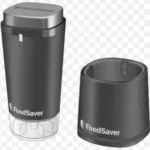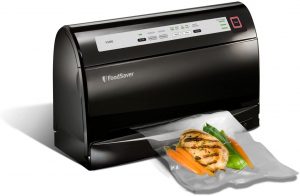
Quick Start Guide and User Manual

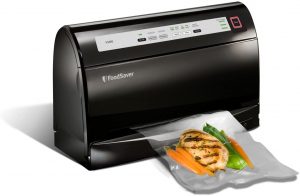
FoodSaver Vacuum Sealing System V3400
Registering your appliance is quick and easy at www.prodregister.com/foodsaver. If you register on our website, 10 you will have the opportunity to receive special bag and accessory introductory offers. Refer to the registration card in the box.
For more usage tips and safety information, please refer to the FoodSaver® Reference Guide or visit our website at www.foodsaver.com.
Features of Your FoodSaver® Appliance
(Note some features may vary slightly by model)

* not available on all models
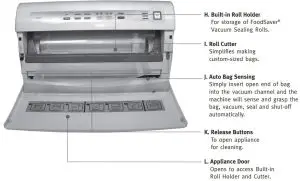
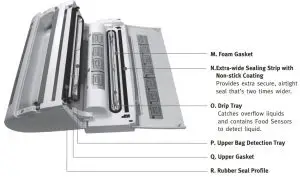

- Power Button
Press the power button to begin. The Power Indicator, Speed Indicator and Food Indicator lights will become illuminated. After Vacuum Sealing, press Power Button to turn appliance Off. Note: After 12 minutes, the appliance will turn Off automatically. - Tray Full indicator light
During the vacuum sealing process, small amounts of liquids, crumbs or food particles can be inadvertently pulled into the Drip Tray (O). When excess liquid fills the Drip Tray, the unit will turn off and the Tray Full Indicator (2) will activate. To resume normal operation, remove the Drip Tray, empty liquid, wash in warm soapy water or place in top rack of dishwasher. Dry and replace Drip Tray in trough. (See Care and Cleaning) - Marinate MODE Button
A ten minute predetermined sequence of vacuum pulse to rest ratio allowing foods to get optimum flavor infusion in the least amount of time. See “Marinating with your FoodSaver®” section on page 5. - Canister MODE Button
Press to achieve best vacuum for canisters and accessories. Push Canister Vacuum Button (4) to begin vacuum process. Motor will run until Vacuum Sealing Process is complete. - SPEED SETTINGS BUTTON*
When vacuum sealing delicate items, press Speed Setting Button (5) so that the gentle speed indicator light is illuminated. For more control you may press Seal Button (9) at any time to stop vacuum and begin automatic sealing process. Note: Appliance will default to Normal speed upon pressing the Power On Button or when power has been interrupted. - ADJUSTABLE FOOD SETTINGS BUTTON For optimal vacuuming and sealing of moist or juicy foods, press the Adjustable Food Setting Button (6) until the Moist Indicator Light is illuminated. Choose the dry food setting for foods without liquid. The Moist Food Indicator light will flash when Food
Sealing Sensors automatically detect any moisture or liquid in the drip tray (O). Note: Appliance will default to Dry setting upon pressing the Power Button or when power has been interrupted, unless liquid is detected in the Drip Tray. (See Care and Cleaning section of this Quick Start Guide). - Cancel Button Immediately halts the current function opening the Vacuum Channel.
- Vacuum Progress display
Displays vacuum levels as the bag/canister is evacuated. - SEAL BUTTON
CrushFree™ Instant Seal feature-
This button has four uses:
- Press to immediately stop the vacuum process and begin sealing the bag. This prevents crushing delicate items such as bread, cookies and pastries.
- Press to create a seal when making bags from a FoodSaver® Roll.
- Press to create a seal on Mylar bags (such as a potato chip bag) to keep food sealed airtight.
- Press during PulseVac™ mode to seal bag.
10. Seal Indicator Light
Constant Red light indicates sealing process is engaged. (Flashing light indicates error)
Care and Cleaning
To Clean Appliance:
Unplug before cleaning. Open appliance door (D), while holding the appliance with two hands, press two Release Buttons (K) with your thumbs, rotate appliance away from you, and allow appliance to rest on the counter.
Check Foam Gasket (M) around Drip Tray (O) and Upper Gasket (Q) which surrounds the Upper Bag Detection Tray (P) to make sure they are free from food materials and the lower Foam Gasket is properly inserted into gasket channel.
For important product maintenance information and helpful tips, please refer to the FoodSaver® Reference Guide included in your kit.
Antibacterial Drip Tray & Upper Bag Detection Tray Empty Drip Tray after each use (See Fig. 7). Wash in warm soapy water or place in top rack of dishwasher. The Food Sensors in the Drip Tray (O) will not function correctly if liquid is allowed to remain in Drip Tray.
This appliance has a Tray Full indicator (2) . When excess liquid fills the Drip Tray, the unit will turn off and the Tray Full Indicator light will activate. To resume normal operation, open Appliance Door (D), press two release buttons (K), rotate appliance away from you, and allow appliance to rest on the counter. Remove the Drip Tray, empty liquid, clean Drip Tray and replace in housing. When replacing drip tray, set the right end of the drip tray into place, then firmly snap the left side down (See Fig. 8). Appliance can be used without Drip Tray, however the Adjustable Food Sensor setting (6) will not function without the Drip Tray.
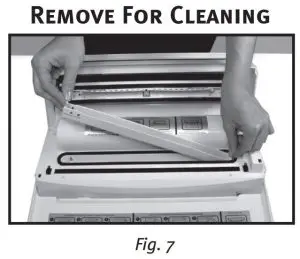
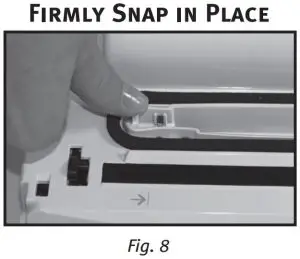
Clean Upper Bag Detection Tray after each use. The Upper Bag Detection Tray (P) is removable for cleaning, remove by lifting the tabs on each end. Do not pull on the Upper Bag Detection Flags to remove the Upper Bag Detection Tray. Clean Upper Bag Detection Tray by washing in warm soapy water or placing in top rack of dishwasher. Upper Bag Detection Tray MUST be inserted to use the appliance. Without the Upper Bag Detection Tray, your FoodSaver®
Appliance will not detect bag when inserted in the Vacuum Channel (E). After cleaning, hold appliance with two hands and rotate upright until the latches lock.
For important safety information and helpful tips, please refer to the FoodSaver® Reference Guide included in your kit. Questions? Visit us at www.foodsaver.com to get tips on vacuum sealing and order FoodSaver® brand accessories, bags and rolls, or call 1-877-777-8042 (U.S.).
How to Make a Bag from a FoodSaver® Vacuum Sealing Roll
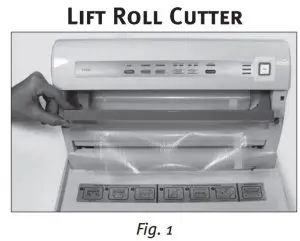
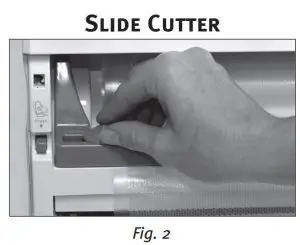
- Open appliance door and place roll into Roll Storage Compartment (H). For Best results, insert roll with material flap down. Note: Bags can be sealed with appliance door either open or closed.
- Lift up Bag Cutter Bar (i) and place bag material beneath the cutter bar (See Fig.1).
- Pull out enough bag material to hold item being vacuum packed, plus 4 inches. Lower the Cutter Bar and slide Bag Cutter (i) across the Cutter Bar (See Fig.2).
- Press Seal Button (C). Red seal light will illuminate.
- Using two hands, insert open end of bag into Vacuum Channel (E) until clamp motor starts. Bag must be centered between arrows.
- When red seal light (10) turns off, sealing is complete. You may remove bag from the Vacuum Channel (E).
- You now have one sealed end.
- Now you are ready to vacuum seal with your new bag (See below).
How to Vacuum Seal with FoodSaver® Vacuum Sealing Bags

- Begin with a FoodSaver® Vacuum Sealing System Bag (or create a bag as described in the “How to Make a Bag from a Roll” section above).
- Place item(s) in bag, allowing at least 3 inches of space between bag contents and top of bag.
- Using two hands, insert open end of bag into Vacuum Channel (E) until clamp motor starts (See Fig.3). The vacuum progress lights will illuminate. Continue to hold bag until vacuum pump starts. You may now release bag. Note: To prevent crushing delicate items, you may press Seal Button (C) at any time to begin automatic sealing process.
- When red Seal Light (10) turns off, remove bag. Refrigerate or freeze if needed. (See FoodSaver® Reference Guide for food safety tips.) Note: Wait at least 20 seconds between seals to allow appliance to properly cool.

Pre-cut bag storage* (See Fig. 4)
Some models include a storage tray for precut bags. Attach the pre cut storage tray to the back of the housing by aligning the four tabs into the corresponding slots of the back of the appliance housing. Once aligned, gently press storage tray downward until the storage tray clicks into place.
For information on how to purchase the pre-cut bag storage, please visit our website at www.foodsaver.com.
Marinating with your FoodSaver® Appliance
Your FoodSaver® Vacuum Sealing System has a special Quick Marinate Cycle which will last about ten minutes. The vacuum motor will “hold” the vacuum for several minutes then release the vacuum allowing the food to “rest” for 30 seconds. This process will then repeat two more times. This “Pulsing” action of “vacuuming and resting” will allow for quicker marinating. When the Quick Marinate Cycle is completed the appliance will beep to signal marinating is complete.
The FoodSaver® Quick Marinator Canister is the perfect FoodSaver® Accessory for marinating foods. Foods will marinate in minutes when vacuum sealed because the vacuum process opens the pores of the food and absorbs the marinade more quickly.
Important Note: Use the FoodSaver® Quick Marinating Canister with clear lid and large white knob. During the Quick Marinate Cycle, make sure knob on accessory lid is set to OPEN. Do not set knob to Vacuum. The Vacuum position on the knob will allow the Quick Marinating Canister to be used for extending vacuum storage.
- Prepare enough of your favorite marinade to fully cover food inside a marinating canister. Always leave at least one inch of space between contents and top of rim.
- Make sure rubber gasket underneath lids as well as rim of marinating canister is free from food materials.
- Make sure Accessory Hose is securely inserted into port on the FoodSaver® Quick Marinator lid.
- Make sure knob on accessory lid is set to OPEN.
- Make sure lid is firmly attached to marinator base.
- Press Marinate button (3) on the control panel.
- Your FoodSaver® Vacuum Sealing System will now begin the Quick Marinate Cycle. The Marinate Indicator Light will flash to indicate the marinating process has begun.
- During the initial vacuum cycle the Marinate Mode Indicator will illuminate. While Marinating, the Vacuum Progress Display will blink during the Vacuum Hold or Rest Cycle.
- To preserve food safely, after completing the marinating cycle, the appliance will signal with short beeps to indicate your Quick Marinate Cycle is completed. Press any button to silence the signal. You may now cook or refrigerate your marinated food.
Tips for Successful Vacuum Sealing
General Tips
Tips for Successful Vacuum Sealing
- Vacuum sealing is NOT a substitute for the heat process of canning. Perishables still need to be refrigerated or frozen.
- For best results, use FoodSaver® brand Bags, Canisters and Accessories.
- During the vacuum sealing process, small amounts of liquids, crumbs or food particles can be inadvertently pulled into Drip Tray (O), clogging the pump and damaging your appliance.
To prevent this, follow these tips:
a. For moist and juicy foods: Freeze first and avoid overfilling bags. You can also place a folded paper towel inside top of bag, and below seal area, before vacuum sealing.
b. For soups, sauces and liquids: Freeze first and avoid overfilling bags. Or, use a canister in refrigerator.
c. For powdery or fine-grained foods: Avoid overfilling bags or use a canister. You can also place a coffee filter or paper towel inside before vacuum packaging.
d. Empty drip tray (O) after each use. - To avoid overfilling, always leave at least 3 inches of bag material between bag contents and top of bag. Then leave at least one additional inch of bag material for each time you plan to reuse bag.
- Do not create your own side seams for a FoodSaver® brand Bag. Our bags are manufactured with a special side seam, which is sealed all the way to the outer edge.
- To prevent wrinkles in a seal when vacuum sealing bulky items, gently stretch bag flat while inserting into the vacuum channel and hold until pump begins.
- If you are unsure your bag was sealed properly, simply reseal bag.
- When you are vacuum sealing items with sharp edges (dry spaghetti, silverware, etc.), protect bag from punctures by wrapping item in soft cushioning material, such as a paper towel. You may want to use a canister or Mason jar instead of a bag.
- When using accessories, remember to leave one inch of space at top of canister or container.
- Pre-freeze fruits and blanch vegetables before vacuum sealing for best results. See FoodSaver® Reference Guide included with your appliance for more information.
- If appliance does not function, or Seal button (C) flashes to signal ERROR:
a. Check power cord to see if it is firmly plugged into an electrical outlet.
b. Examine power cord for any damages.
c. See if electrical outlet is working by plugging in another appliance.
d. Check to be certain the Upper Bag Detection Tray (P) is properly inserted.
e. Make sure bag is placed correctly inside Vacuum Channel (E). (See How to Vacuum Seal with FoodSaver® Vacuum Sealing Bags) f. Check to ensure Release Buttons (K) are properly latched.
g. Check Foam Gasket (M) around Drip Tray to make sure it is free from food material and is properly inserted into gasket channel.
h. Check Upper Gasket (Q) around Upper Bag Detection Tray (P) to be sure it is free from food material.
i. If overheated, allow appliance to cool for 20 minutes.
j. For more usage tips and safety information, please refer to the FoodSaver® Reference Guide or visit our website at www.foodsaver.com.
Tips on Removing Air from a Bag
Avoid wrinkles when inserting the bag into the Vacuum Channel (E).
Wrinkles in seal may cause leakage and allow air to return into bag. To eliminate any wrinkles while inserting bag into the vacuum channel (E), hold bag with two hands gently stretching bag flat until vacuum pump begins. If you find wrinkles after sealing bag, simply cut bag open and vacuum seal again.
If motor runs for more than 30 seconds without stopping, consider the following:
If you are vacuum sealing with a bag, make sure the bag is properly sealed (See “How to Make a Bag From a Roll”). Check foam gasket around Drip Tray to make sure it is free from food material and is properly inserted into gasket channel.
If vacuum sealing with an accessory, check Accessory Hose connections to ensure a tight fit.
Tips on Sealing a Bag
When making a bag from a roll:
Press the Seal Button (C) before placing bag material into the Vacuum Channel (E). Once bag in inserted the Seal process will begin immediately.
Note: If you forget to press the Seal Button (C) before inserting the bag into the Vacuum Channel (E), the vacuum pump will turn on, this is not a problem, simply press the Seal Button to prevent the pump from running continuously, and the sealing process will begin.
How to Prevent moisture or liquid from being pulled into the Drip Tray (O) or getting trapped in the seal:
Either pre-freeze moist food such as raw meat for 1-2 hours before vacuum sealing, or place a folded paper towel between food and end of bag to absorb excess liquids. Be sure to leave at least 3 inches between paper towel and end of bag so that bag seals properly with paper towel inside and is not positioned in between the seal area. Make sure appliance has time to cool down.
Wait at least 20 seconds between seals. Under very heavy usage, appliance will stop operating to prevent overheating. If it does, wait 20 minutes to allow appliance to cool off.
Tips on Using the Intergrated Bag Opener
The Bag Opener is a handy and convenient way to open sealed bags.
To Use:
- Press Bag Opener to extend (press again to retract Bag Opener for storage).
- Fold end of bag to create a loop (as shown in Fig.5) with the sealed bag so the Heat Sealed area is above the cutter.
- Hold bag taught with two hands and pull bag through the cutter (See Fig. 6).
Note: Bags that previously contained fruits, vegetable and dry goods can be resealed. Bags that contained raw meats, fish eggs or unpasteurized cheese should be discarded after use becase they may contain invisible bacteria that will remain after washing.
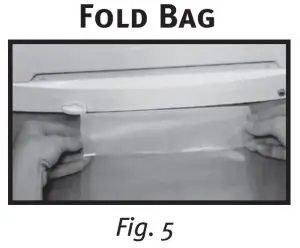

Tips on Vacuum Sealing with Accessories
How to prepare FoodSaver® Accessories for Vacuum packaging
Accessories include FoodSavor Vacuum Packaging Canisters, containers, Universal Lids, Jar Sealers and Bottle Stoppers.
- Always leave at least one inch of space between contents and rim.
- Wipe rim of canister, container or bottle to ensure it is clean and dry.
- Place lid on canister or container, or place stopper in bottle.
- For accessories with a large knob on lid, turn knob to Vaccum. Vacuum package using instructions below. When vacuum process is complete, turn knob to Closed before removing Accessory Hose.
- For Accessories without a large knob on lid, vacuum package using insttuctions below.
FoodSaver® Vacuum Sealing Accessories*
How to Open FoodSaver® Vacuum Sealing Accessories after Vacuum Sealing
FoodSaver® Vacuum Sealing Canisters (without large knob on lid)
To release vacuum and open, push gray rubber button on lid.
Quick Marinators (with large knob on lid) and Universal Lids
To release vacuum and open, turn knob counterclockwise on lid to open.
FoodSaver® Jar Sealer with Mason Jars
For use with Ball® and Kerr® brand Mason jars.
To release vacuum and open, wedge spoon between Mason jar lid and highest part of threaded rim. Twist spoon gently to release vacuum.
IMPORTANT: Do NOT use screw bands when vacuum sealing jars.
FoodSaver® Lunch and Leftover and Sandwich and Snack Containers
Attach the supplied adapter to the accessory hose and place the adapter over the vacuum valve of the Container lid. While applying downward pressure to the adaptor, press the Canister Button. Once the air has been removed from the Container, the Sealer will automatically turn off.
FoodSaver® Bottle Stoppers
To release vacuum and open, simply pull up on Bottle Stopper. Always unplug appliance before cleaning.
How to use Accessory Hose
- Prepare container according to FoodSaver(R) Accessory Guidelines .
- With appliance door (D) closed, insert one end of Accessory Hose into Port (F) on appliance. Insert other end into port on accessory. Twist gray tab whileinserting to ensure a tight fit.
- Push the Canister Vacuum Button (4). Motor will run until vacuum process is complete.
- When motor turns off, gently twist and remove Accessory Hose from accessory and appliance.
- To test vacuum, simply tug on accessory lid. It should not move.
Note: For important tips on using accessories with different foods, please refer to the FoodSaver Reference Guide.)
